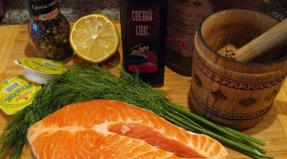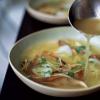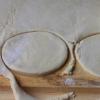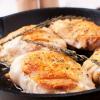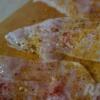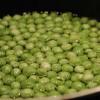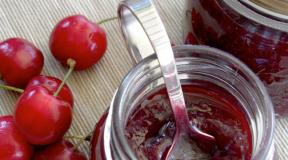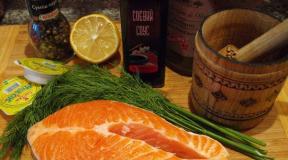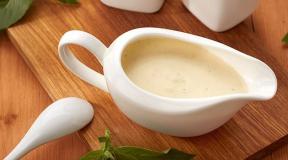How to cook bozbash beef soup in Azerbaijani style according to a step-by-step recipe with photos. Azerbaijani cuisine What is the name of Azerbaijani soup
20 best soup recipes
2 hours 20 minutes
150 kcal
5/5 (6)
The number of servings can be changed by proportionally increasing or decreasing the amount of ingredients. In this case, the cooking time practically does not change.
Did you know?
100 g of soup, depending on preparation, contains approximately 20-25 g of protein, 10-12 g of fat, 28-32 g of carbohydrates and about 300 kcal.
Kitchen utensils needed for cooking
- 4-liter saucepan;
- cutting board;
- tablespoon and teaspoon;
- kitchen stove.
Ingredients
For cooking, I advise you to choose: meat – on the bone (for richness of the soup); peas – Turkish (chickpeas); vegetables – medium size; tomato sauce (or tomatoes) – in its own juice; pepper – in grains (grind just before cooking).
The amount of ingredients, especially spices, can be adjusted and added depending on your preferences.
Important! A few hours before starting to prepare the soup, peas (chickpeas) must be soaked in cold water. It is best to leave the chickpeas in water overnight. Before adding peas to the soup, drain the water and rinse the chickpeas. Pour the peas into the pan without water.
Step-by-step cooking process
- Prepare the ingredients. Peel the onions and potatoes. Chop the onion into small pieces, approximately 5-7 mm. Cut the potatoes into rings, approximately 5-7 mm thick. Divide the meat into large portions, approximately 2-3 cm.

- Melt 50 g butter in a saucepan,

then pour the chopped onion into it, which we fry until slightly golden brown.
- When the onion is ready, add 200 g of tomato sauce to the pan and simmer, stirring constantly, over low heat until approximately half of the tomato sauce liquid has evaporated.

- When our frying of onions and tomato sauce is ready, add the chopped meat and bones left after trimming the meat to the pan.

Simmer the meat, stirring occasionally, until it acquires the gray-pink (brownish) color characteristic of cooked beef. - When the beef changes color, pour the peas into the pan


Salt, pepper, add turmeric to taste. Bring to a boil, then turn the heat on the stove to low and leave to simmer until the meat and peas are fully cooked. - When the meat and peas are cooked, add chopped potatoes to the pan and cook over low heat.

When the potatoes are cooked, turn off the heat on the stove and let it brew for 30 minutes, after which the soup is ready.
Did you know? To speed up the process of preparing soup, vegetables and meat can be prepared not in advance, but as the soup is being prepared. For example, first we prepare only the onion, and while it is fried, we prepare the meat. We prepare the potatoes when the meat and peas are cooked. But if you still decide to prepare the ingredients in advance, after cleaning and cutting, do not forget to fill them with water so that they do not weather and oxidize.
Video recipe
You can see how to prepare the ingredients and prepare the soup in this video.
Decorating and serving soup
Before serving the soup, it is usually sprinkled with chopped parsley. You can also use dill, basil, cilantro, green onions and garlic, and other herbs as decoration.
Cooking options
Bozbash, like borscht, has many different cooking options, which depend on the region of preparation and the time of year. The classic bozbash is lamb soup, but both beef and chicken are often used.
In some regions, bozbash is not prepared as described in this recipe (meat with onions, tomatoes and chickpeas are poured with water), but first the meat broth is boiled, into which all the ingredients are gradually added.
If instead of whole pieces of meat you add meatballs to the soup, it will be kufta-bozbash. In this cooking method, the meatballs are made very large (the size of half a palm), and several pieces of dried cherry plum are placed inside the meatballs.
Bozbash also varies in composition of ingredients. In winter, they usually use tomato sauce or tomatoes in their own juice. In summer - fresh tomatoes, cherry plum, dried fruits, sour blocks. You can use chestnuts instead of potatoes. At the end of cooking, add pomegranate or lemon juice to the soup.
The religion of the people has left its mark on the menu: Muslim rules do not allow eating pork, so in Azerbaijan, meat dishes are mainly prepared from lamb, and the fish diet consists of representatives of the sturgeon and salmon families.
Warm, welcoming Azerbaijan is a country with very fertile soil, numerous varieties of fruits and vegetables grow there, which are readily and almost always added to food.
The combination of ingredients can sometimes be overwhelming, but the dishes turn out incredibly tasty and nutritious. A characteristic feature of Azerbaijani cuisine is that various spices, herbs and seasonings are added to all dishes without exception.
In the houses of this country there is always a pleasant aroma that evokes appetite. In addition, in some regions and villages, women still cook in old traditional utensils made of copper. It is believed that such an alloy improves the taste of the dish.
Top 10 popular Azerbaijani dishes
Among several thousand ancient Azerbaijani recipes, it is difficult to single out just a few of the best: all dishes of national cuisine are extremely good, and, importantly, healthy due to the addition of a huge amount of fresh herbs and fruits. But there are several particularly popular dishes that have long become known in Europe.
1. Adjapsandal
This dish is often found in the cuisines of other peoples of the world - Armenian, Turkic, Georgian and many others, but ajapsadal was originally a traditional cold appetizer of Azerbaijan. This is a vegetable dish based on eggplants, tomatoes and sweet peppers. Additional flavor enhancing ingredients include white onions, fresh coriander, garlic and basil. Vegetable oil is used as a dressing.
In European countries, this dish, the name of which translates as “how excellent you are,” would be dubbed vegetable sauté. But in a traditional sauté, eggplants are not a mandatory ingredient, unlike Ajapsandal; in addition, in Europe they use completely different seasonings, so the Azerbaijani dish remains unique and one of a kind in terms of taste.
2. Pilaf
Of course, pilaf is most often associated with Azerbaijani cuisine. There are about 200 recipes for this dish in Azerbaijan. It is believed that this nation prepares pilaf better than other peoples of the Caucasus and the entire population of the world as a whole.
The dish really turns out consistently tasty, no matter what recipe it is prepared in. But there is one remarkable feature: the rice itself and the “filling” are prepared separately from each other, and mixed only in a plate served to the table. Rice porridge is made in a cast iron or copper cauldron, in butter, or using fat tail fat.
Garou is prepared in a separate container - a mixture of pieces of lamb, spices, vegetables and fruits. Even the dish is served in a surprising way: the rice is covered with several triangular pieces of kazmag (unleavened flatbread), sprinkled with pomegranate seeds, and the garou is served in a separate plate. To all this they add a traditional drink - sherbet.

3. Dolma
This dish is somewhat similar to ordinary Russian cabbage rolls, but it also has significant differences. Firstly, quince or grape leaves are used instead of cabbage leaves. Secondly, Azerbaijani dolma can have completely different fillings.
The traditional option is lamb dolma; fresh herbs and clear rice are added to the minced meat; these ingredients should not exceed the volume of the minced meat. As a rule, they take 3 parts of minced lamb and 1 part of rice with herbs.
In Azerbaijan, there are about 10 recipes for dolma with different fillings, including fruits, vegetables, and fish. Each option is popular: in summer, light vegetable dolma is served with a traditional fermented milk drink; in winter, a fish or meat hot dish is appropriate. It is noteworthy that it has not yet been established exactly what national cuisine this dish came from.
Today it is an integral part of the diet of Azerbaijan, Georgia and Armenia, but it was Azerbaijan that made every effort to ensure that the dish was recognized as traditional for the Azerbaijani people. It’s interesting that everything worked out: just a year ago, the culinary traditions of preparing Azerbaijani dolma were recognized as the cultural heritage of humanity.

4. Lula kebab
Another must-try meat dish in the country. It is a minced lamb cutlet cooked over coals or an open fire. It is noteworthy that no onions or eggs are added to the minced meat; the minced meat is simply beaten for a long time and thoroughly, after which it is placed on a thin wooden skewer.
There are enough options for preparing kebabs; in common parlance this is kebab, therefore, as in any other cuisine, kebab can be made from fish, vegetables or meat. But the presentation is always the same: meat generously sprinkled with herbs on thin homemade flatbreads.

5. Dyushbara
This dish is akin to classic dumplings, in fact, dumplings in Azerbaijani style. For preparation, minced lamb is made with the addition of various spices and herbs, the dough is kneaded into a stiff dough with a small amount of salt.
A distinctive feature of the national dish is that the preparations are not dipped into water, but into a boiling broth made from lamb bones. Dushbara is served in broth with butter and fresh herbs, which take up at least a third of the plate.

6. Dzhyz-byz
In Azerbaijan, it is customary to eat not only clean meat, but also its waste. Thus, the popular Azerbaijani dish jiz-byz is processed young sheep intestines fried with potatoes. The dish also includes other animal entrails - liver, kidneys, heart. Fat tail fat is always used for frying, and the finished dish, richly seasoned with herbs, is served in sumy.

7. Bozbash
One of the many first courses of Azerbaijani cuisine. Almost all soups of this cuisine have a slightly different consistency from the one we are used to: Azerbaijani soups have much more filling and very little liquid, due to which the dishes are always very high in calories and nutritious. Bozbash is a fatty soup with numerous ingredients.
The main vegetables are: potatoes or chestnuts, sweet peppers, tomatoes, chickpeas, onions, zucchini and eggplants. A distinctive feature is that the traditional recipe always contains mint and apples, which adds some piquancy to the dish.

8. Petey
Another interesting soup that is cooked in the oven. A very thick lamb belly dish. The cooking process takes place in several stages: vegetables (onions, peppers, carrots, eggplant) are first fried in fat tail fat, and then transferred to a clay pot. The mixture is poured with a small amount of liquid and brought to readiness in the oven. When serving, piti must be decorated with coriander.

9. Khash
In Azerbaijani cuisine, almost all hot dishes and soups are made from lamb; only a few recipes include beef or veal. Khash is one of them. Despite the fact that this is a soup and is served hot, it is traditionally eaten exclusively for breakfast.
Khash is prepared without any spices at all, based on beef tripe; in some regions, beef tails and heads are added. In addition, this is one of the few dishes that is not sprinkled with herbs. When serving, spices, herbs and herbs are simply served in a separate bowl, but only to guests of the country. The local population eats khash without any spices at all.

10. Baklava
A traditional Azerbaijani sweet, which is always present on the table on the great Muslim holiday of Novruz Bayram, this dish is also served to all guests. The basis of baklava is yeast dough, hazelnuts, and other ground nuts. Additional and required ingredients are saffron, cloves, sugar. Baklava is a kind of sweet multi-layer cake.
To prepare an oriental sweet, roll out a layer of dough, sprinkle generously with filling in the form of nuts and sugar, then cover the mixture with another layer of dough, grease it with butter and add the filling again.
Similar actions are continued until the future dish has 10 layers, the latter is coated with egg yolk and saffron, after which the workpiece is sent to the oven for half an hour. When the delicacy is ready and cooled, it is cut into diamond-shaped pieces, each of which is decorated with whole hazelnuts.
Are you wondering what kashyk hengel means? “Kashyk” translated from Azerbaijani means spoon, hengel means diamond-shaped or square pieces of dough, that is, dough eaten with a spoon. This is a traditional soup of Azerbaijani cuisine. It is usually prepared in winter. The soup is rich, satisfying and perfectly warms you up during the cold season.
The peculiarity of this dish is that it contains dough cut into small pieces - hengeli. Steep dumpling dough is kneaded, rolled out thinly and cut into squares with a side of 1-1.5 cm. Separately, cook the lamb or beef broth. Add fried onions and hengeli to the prepared and strained broth and cook until the dough is ready. At the end, add cilantro or dried mint to taste.
In some regions of Azerbaijan, it is customary to put pre-boiled chickpeas in kashyk hengel. The soup must be served with sarymsakh-gatyg sauce: natural yogurt with garlic, which will give the dish a little spiciness and a light, pleasant sourness.
Azerbaijani cuisine is one of the most original and unique cuisines in the world. Despite the fact that the life of Azerbaijanis is very closely connected with the life of neighboring peoples (Armenians, Georgians, Turks, Persians, Lezgins), the national cuisine of Azerbaijan still managed to maintain its originality and bright color, attracting the attention of millions of people from all over the world.
We will begin the description of Azerbaijani cuisine, perhaps, with local gastronomic taboos - pork and alcohol, which are not represented in any way in the recipes of traditional dishes, because almost the entire population of Azerbaijan considers themselves Muslims. Otherwise, there are no restrictions, so each of us will certainly be able to find something valuable, appetizing and tasty for ourselves here.
Meat dishes of Azerbaijani cuisine are prepared mainly from lamb. Poultry, fish and beef are also found here, but much less frequently than lamb. Moreover, most dishes have a very pronounced spicy taste, since Azerbaijanis highly respect spicy herbs and spices. Basil, saffron, cilantro, turmeric, various peppers, sumac, fennel, cumin, cumin - all this and much more is added to almost every meat dish (not at the same time, of course) and creates a truly magical taste and aroma. This is especially true for saffron, which is an integral part of such a dish as pilaf (the main dish of Azerbaijani cuisine), and sumac, which is added everywhere (where the main component is meat).
Vegetables and fruits are used as food here no less often, if not more often, than meat and cereals (especially in season). But the soups... There are about a dozen traditional soup recipes in Azerbaijan, which is quite good for the national cuisine of one people. In our area, for example, so many traditional soups may easily not be available (meaning Russian cuisine), even if you dig deep into the archives.
The national Azerbaijani cuisine is also rich in baking recipes - both sweet and savory; cold appetizers, several types of bread and even vegetarian dishes (albeit few in number) are prepared here. In general, if you want to get to know the national cuisine of Azerbaijan better, then feel free to start. It will be interesting! Well, we will help you with this.
In this collection, we have collected for you the best recipes for dishes of national Azerbaijani cuisine with step-by-step photographs and detailed instructions performed by our authors. Welcome to the culinary world of Azerbaijan!
Azerbaijanis love and know how to cook deliciously, but strict religious norms dictate certain restrictions for Muslims. Islam also left its mark on the national dishes of Azerbaijan. Recipes, for example, call for any meat except pork.
Azerbaijani cuisine
A characteristic feature of Azerbaijani cooking, in contrast to Russian, is that here in every kitchen there is always a strong aroma of spices. It is customary to complement Azerbaijan with a generous set of spices. are used in huge quantities. These are such well-known plants as basil, mint, dill, parsley, as well as sumac, saffron, cumin, fennel, various types of pepper, cinnamon, cloves and many others.
National dishes of Azerbaijan include all kinds of vegetables and fruits. Even in soups and hot meat snacks, fresh and dried cherry plums, grapes, figs, apples, apricots, plums, barberries, pomegranates, citrus fruits, etc. are added.
Azerbaijani chefs also know a lot about preparing desserts. Various dried fruits and nuts are crushed and, together with cinnamon, honey, saffron and mint, improve the taste of original sweets - nougat, Turkish delight, firni, baklava, kurabye, halva. They are also used for filling shor-kogal, shakerbura, zeyran, mutaka, kyata and many other sweet products made with or without dough.
For cooking, housewives take special containers - cauldrons, pitishniki, saji, tandoors and others, but this is not a mandatory requirement, they are just very convenient and, as a rule, have thick walls and special cavities for hot coals or electric heaters.

Baku pilaf
Azerbaijani pilaf with dried fruits and meat is a complex dish that is prepared in several stages.
Rice is cooked separately - 1 kg of cereal should be poured into a cauldron with plenty of cold water and put on fire. When it boils, add 2 tbsp. spoons of salt. Cook the rice until half cooked, then rinse with hot water and drain in a colander.
5-6 tablespoons of ghee are poured into the bottom of the cauldron, a flat cake is placed on the butter, and prepared rice is poured onto it in a heap. Add half a glass of saffron infusion, cover with a lid and simmer over low heat for about an hour.
Nar guvrum is prepared separately - it is usually lamb, but you can also use chicken. For the dish you need to cut 1 kg of meat into pieces, add salt, pepper, sprinkle with cumin and place in a roasting pan with melted butter. Fry over high heat. At the end, add two heads of finely chopped onions and dried fruits (apricots, figs, prunes, sultanas and barberries). Stir and pour in hot water with half a glass of saffron infusion. Simmer until the meat is done.
When setting the table, place the rice with the gazmakh broken into pieces on a large dish, spread the nar guvruma beautifully and sprinkle with pomegranate seeds.
Azerbaijani pilaf with dried fruits and meat can be made in a slow cooker. In this case, the cooking time will be significantly reduced.

Lamb offal dish
This dish is called jiz-byz. It uses the intestines, heart, lungs, testes, kidneys, liver and fat tail fat of a young sheep, as well as 2 onions, potatoes and spices (pepper, sumac, cumin, salt).
Jiz-byz, like many national dishes of Azerbaijan, is cooked in a special cauldron.
It is melted in a cauldron, and washed and cut into small pieces, giblets, spices and chopped onions are placed in it. Everything is fried over high heat, then potatoes are placed in the cauldron and hot water is added. Everything is stewed for about 40 minutes. Served sprinkled with cilantro, basil, dill and other herbs.

Khamrashi soup
Azerbaijani soup Khamrashi is prepared just before serving, as noodles are added to it, which lose their taste due to being in the broth for a long time. As for the beans, it is better to cook them in advance or soak them overnight.
National dishes of Azerbaijan are often prepared from young lamb with the addition of legumes. Khamrashi is no exception. For it, the meat should be minced and combined with salt and pepper. Add salt and spices to the pan with boiled beans. Bring to a boil, form the minced meat into large meatballs, place them in the pan and leave to cook.
Prepare unleavened dough from flour and water, roll it into a very thin layer and cut into small strips. Place the resulting noodles in a pan with beans and meatballs. Bring to a boil and turn off the heat.
Serve generously sprinkled with chopped cilantro, basil, mint, coriander and parsley.

Azerbaijani okroshka ovdukh
Azerbaijani-style okroshka is made not with kvass, but with the fermented milk drink matsoni. The composition of ovdukh includes boiled eggs, fresh cucumbers, green onions, cilantro, dill and garlic, mashed with salt. All of the listed components need to be cut, put in a plate and poured over the matsoni. The ingredients are combined immediately before serving, and before that they are stored separately in the refrigerator.
Sometimes pieces of boiled lean beef are added to okroshka.

Chagyrtma
National dishes of Azerbaijan rarely leave anyone indifferent. This also applies to Chagyrtma. The tasty and nutritious dish includes a lot of onions, chicken with bones, eggs, butter, bell peppers, fresh tomatoes, aromatic herbs and dry spices.
The chicken must be cut into small pieces, 60 grams each, salted, sprinkled with spices, poured with a small amount of grape vinegar and left to marinate.
Dip 1 kg of tomatoes into boiling water and remove the skin.
Finely chop one to one and a half kilograms of onions, add salt, add pepper, cumin, saffron infusion and simmer in a cauldron until soft and puree-like. To prevent the onions from burning, add hot water little by little, but not oil.
Mix butter, 200 grams, with onion, 45 minutes after the start of stewing.
After another 5 minutes, put the chicken pieces in the onion and simmer everything together for about 30 minutes.
Break 8-10 eggs into a bowl and lightly beat with a whisk to obtain a homogeneous cream-colored mass. Pour it into the cauldron, stirring constantly.
Immediately after this, cut the tomatoes into small pieces and place in a cauldron. Chop bell peppers and herbs there. Bring to a boil and turn off. Serve hot, placing on separate serving plates.

Lula kebab
Lula kebab is unique. To prepare it, you need to get special flat skewers.
Minced meat is traditionally made from fatty lamb, onions, cilantro, basil, parsley, salt and ground seasonings - pepper, sumac and cumin.
Short, thick sausages are formed from the minced meat and strung on skewers, and then fried on the grill. To make the minced meat viscous, it is passed through a meat grinder twice or kneaded for a long time in an electric processor with knives. After this, the minced meat is beaten on the table and placed in a cold place for 30 minutes. Even without eggs, after such preparation it holds very firmly on the skewer without losing its shape. The finished sausages are placed on thin pita bread and eaten, washed down with warm matsoni.
Lavash is made from unleavened dough consisting of flour, water and salt. To prevent cracks from appearing on the lula kebab when rolling, it must turn out thin and plastic, which is why Azerbaijani lavash is not fried in oil, but baked in a tandoor and used for lula kebab not immediately, but after it has rested and become soft . Since not everyone has a tandoor, it can be successfully replaced by a cast-iron frying pan with a thick bottom.

Dolma
Dolma are very small cabbage rolls that are wrapped not in cabbage, but in grape leaves.
Minced meat is made from lamb, boiled rice, pea puree, onions, salt, pepper and cilantro, basil, parsley and celery. They take half as much rice and peas as meat. The spicy leaves are chopped very finely, and the meat along with the onions is passed through a meat grinder. All ingredients are thoroughly mixed and placed with a teaspoon on grape leaves scalded with boiling water. The leaves are wrapped and dipped in salted boiling water. Cooking time - 30-40 minutes. Dolma is eaten hot, seasoned with matsoni.

Khinkali
Khinkali in Azerbaijani is a product made from unleavened dough, reminiscent of noodles, only more coarsely chopped. Nothing is added to the dough except water and wheat flour. In the cuisines of other nations, khinkali is a cross between dumplings and manti, that is, with filling. Khinkali in Azerbaijani - simple flat squares of dough. They are added to a variety of first and second courses. Khinkali is also served separately, with some kind of sauce, for example, garud sauce and gyimya meat.
For gyim, minced meat is stewed with spices and grape vinegar until soft.
Garud is a sauce made from matsoni and garlic, ground with salt.
Khinkali boiled in salted water is placed on a plate, gyimya is placed on it, garud is poured on top and sprinkled with chopped herbs.

Kutaby
To make kutabs with meat in Azerbaijani style, you need to prepare the dough and minced meat.
The dough requires wheat flour, a little salt and water. It is kneaded quite steeply so that you can roll out a thin flat cake from which to cut out circles with a diameter of 17-19 cm. Place minced meat in the middle, fold the dough in half, like pasties, seal the edges tightly. Fry in a frying pan with oil.
Kutabs with meat in Azerbaijani style are prepared from lamb, so they must be eaten hot, sprinkled with sour sumac. Onions, pieces of sour flatbread made from dried apricots and other fruits, pomegranate juice, salt and pepper are added to the minced meat.

Shaker-churek
This is a traditional sweet dish served with tea. It is very easy to prepare. From 1 kg of wheat flour, two beaten egg whites, half a kilogram of butter and the same amount of powdered sugar, you need to knead the dough and roll it into balls. Dip each ball in the yolk and place on a baking sheet covered with Teflon paper. Bake in a hot oven until golden brown. Place the finished Shaker-Churek balls on a dish and sprinkle with powdered sugar mixed with vanilla or cinnamon.
Firni
Firni is another dessert dish that resembles a very thick jelly or milk porridge. It is not much more difficult to make than shaker churek, and its unusual taste and consistency will surprise those who are not familiar with Azerbaijani cuisine. For firni you need rice flour (100 g), half a liter of milk, a tablespoon of ghee, the same amount of sugar, a little salt and ground cinnamon.
If there is no rice flour, then use regular white rice, grinding it in a coffee grinder. Pour rice flour into boiling milk in a thin stream, add sugar and salt and cook over low heat, making sure it does not burn. At the very end, add butter and stir thoroughly. Serve to guests by pouring into cups and sprinkling cinnamon on top.






